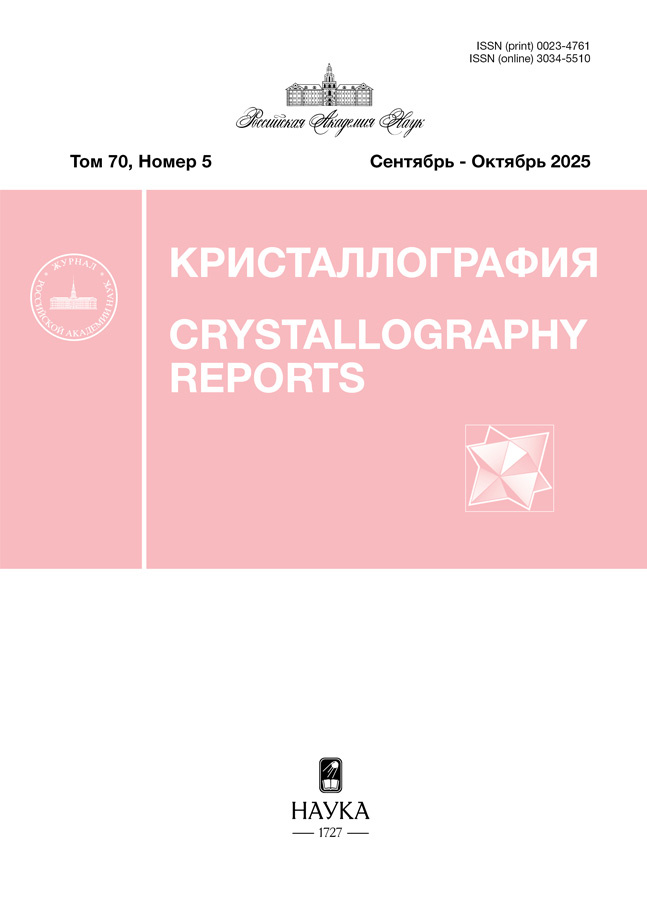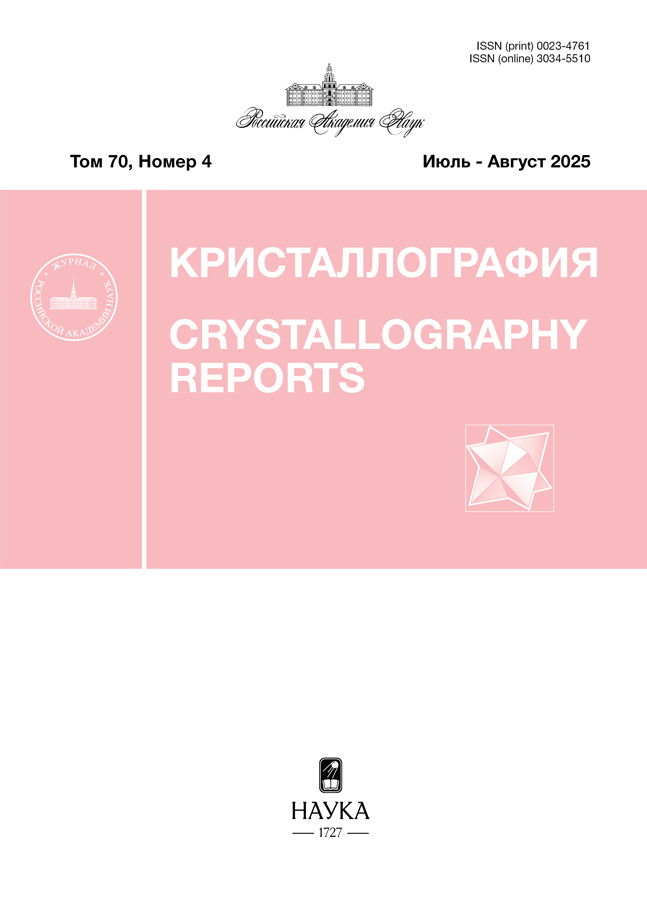Взаимодействие сегнетоэлектрических доменных стенок и форма равновесных зародышей переполяризации
- Авторы: Белов А.Ю.1
-
Учреждения:
- Национальный исследовательский центр “Курчатовский институт”
- Выпуск: Том 70, № 4 (2025)
- Страницы: 577–582
- Раздел: РЕАЛЬНАЯ СТРУКТУРА КРИСТАЛЛОВ
- URL: https://clinpractice.ru/0023-4761/article/view/688080
- DOI: https://doi.org/10.31857/S0023476125040055
- EDN: https://elibrary.ru/JFPZUS
- ID: 688080
Цитировать
Полный текст
Аннотация
Росту зародыша переполяризации в электрическом поле препятствуют силы сцепления, действующие в окрестности его вершин на смыкающиеся доменные стенки. Они могут достигать значительной величины, когда расстояние между доменными стенками становится сравнимым с их толщиной. Показано, что силы сцепления выражаются через коэффициенты разложения энергии Гинзбурга–Ландау, включающего в себя градиентный вклад. Для случая одноосного сегнетоэлектрика получена оценка максимального значения внутреннего поля, связанного с градиентным взаимодействием доменных стенок. Его отношение к внутреннему коэрцитивному полю Eс0 в теории Гинзбурга–Ландау составляет E* max/Ec0 = 3√3/8 ≈ 0.65.
Полный текст
Об авторах
А. Ю. Белов
Национальный исследовательский центр “Курчатовский институт”
Автор, ответственный за переписку.
Email: belov@crys.ras.ru
Отделение “Институт кристаллографии им. А.В. Шубникова” Курчатовского комплекса кристаллографии и фотоники
Россия, МоскваСписок литературы
- Инденбом В.Л. // Изв. AH CCCP. Сep. физ. 1979. Т. 43. С. 1631.
- Инденбом В.Л., Чамров В.А. // Кристаллография. 1980. Т. 25. С. 213.
- Chen I.W., Wang Y. // Appl. Phys. Lett. 1999. V. 75. P. 4186. https://doi.org/10.1063/1.125577
- Chen I.W., Wang I. // Ferroelectrics. 1998. V. 206. P. 245. https://doi.org/10.1080/00150199808009162
- Belov A.Yu., Kreher W.S., Nicolai M. // Ferroelectrics. 2009. V. 391. P. 42. https://doi.org/10.1080/00150190903001128
- Belov A.Yu., Kreher W.S. // Ferroelectrics. 2009. V. 391. P. 12. https://doi.org/10.1080/00150190903001052
- Belov A.Yu., Kreher W.S. // Ferroelectrics. 2007. V. 351. P. 79. https://doi.org/10.1080/00150190701353093
- Viola G., Chong K.B., Guiu F., Reece M.J. // J. Appl. Phys. 2014. V. 115. P. 034106. https://doi.org/10.1063/1.4856235
- Du X., Chen I.W. // Mater. Res. Soc. Symp. Proc. 1998. V. 493. P. 311. https://doi.org/10.1557/PROC-493-311
- Nam S.M., Kil Y.B., Wada S., Tsurumi T. // Jpn. J. Appl. Phys. 2003. V. 42. № 12B. P. L1519. https://doi.org/10.1143/JJAP.42.L1519
- Tsurumi T., Num S.M., Kil Y.B., Wada S. // Ferroelectrics. 2001. V. 259. P. 43. https://doi.org/10.1080/00150190108008714
- Lawless W.N. // Phys. Rev. B. 1978. V. 17. P. 1458. https://doi.org/10.1103/PhysRevB.17.1458
- Jung D.J., Dawber M., Scott J.F. et al. // Integr. Ferroelectr. 2002. V. 48. P. 59. https://doi.org/10.1080/10584580215437
- Mulaosmanovic H., Ocker J., Müller S. et al. // ACS Appl. Mater. Interfaces. 2017. V. 9. P. 3792. https://doi.org/10.1021/acsami.6b13866
- Borowiak A.S., Garcia-Sanchez A., Mercone S. // 2016 Joint IEEE International Symposium on the Applications of Ferroelectrics, European Conference on Application of Polar Dielectrics, and Piezoelectric Force Microscopy Workshop (ISAF/ECAPD/PFM). IEEE. New York, 2016. P. 1. https://doi.org/10.1109/ISAF.2016.7578088
- Белов А.Ю. // Письма в ЖЭТФ. 2018. Т. 108. С. 225.
- Landauer R. // J. Appl. Phys. 1957. V. 28. P. 227. https://doi.org/10.1063/1.1722712
- Tagantsev A.K., Stolichnov I., Setter N. // Phys. Rev. B. 2002. V. 66. P. 214109. https://doi.org/10.1103/PhysRevB.66.214109
- Belov A.Yu. // Ferroelectrics. 2019. V. 544. P. 27. https://doi.org/10.1080/00150193.2019.1598180
- Belov A.Yu. // Ferroelectrics. 2022. V. 590. P. 19. https://doi.org/10.1080/00150193.2022.2037935
- Belov A.Yu. // Mater. Phys. Mech. 2024. V. 52. P. 18. https://doi.org/10.18149/MPM.5212024_2
- Belov A.Yu. // Ferroelectrics. 2025. V. 619. P. 25. https://doi.org/10.1080/00150193.2024.2327956
- Barenblatt G.I. // Adv. Appl. Mech. 1962. V. 7. P. 55. https://doi.org/10.1016/S0065-2156(08)70121-2
Дополнительные файлы














